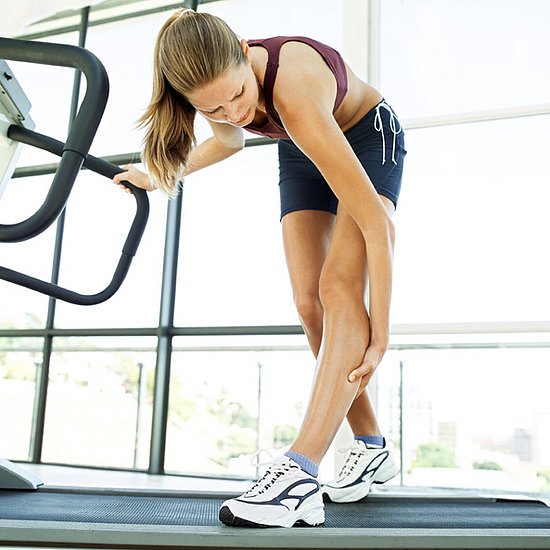Shin splints – shock absorption, stride length

The term shin splints refer to a painful condition that develops in the lower leg, usually along the tibia bone, in response to exercise or activity. Shin splints are a common problem for novice runners, dancers, field hockey, basketball, baseball and tennis players, and even walkers. Shin splints can be classified into different problems including: tendonitis, tendonopathy, periostitis, stress fracture and compartment syndrome. Experts argue whether the diagnoses are distinct entities, but more likely that they can co-exist and progress from one diagnosis to another. Reports document the incidence of shin splints varies from 12% to 18% of running injuries.
Causes of shin splints
Published expert opinion is that a faulty musculoskeletal alignment and imbalance of muscles can be a predisposing factor to the development of shin splints. Hard evidence supporting the contention that faulty musculoskeletal alignment causes shin splints is lacking, and this contention is based more on opinion than evidence. As an expert in identifying faulty musculoskeletal alignment, I question whether it is possible to identify specific alignments which correlate with the development of shin splints, and whether a specific faulty alignment would preclude an individual from participating in walking/running as a form of exercise.
A commonly held belief is that short calf muscles contribute to the development of shin splints and that shin splints can be prevented by regular stretching exercises, however; clinical trials have found no significant effect of leg muscle stretching during warm up before exercise on the incidence of shin injuries.
Increasing the amount of walking/ running suddenly has been implicated as a cause of shin splints. Gillespie (2000) demonstrated that reduction in running and jumping intensity was effective in decreasing the incidence of stress fractures. A contrary study ( acker 2002) controlled the rate of progression of walking/running in a group of military recruits, comparing a group going through basic training in the standard manner against a group where the amount of walking/running activity was in what was thought to be a safe progression. ere was no difference between the two groups in terms of the occurrence of shin splints. is suggests that there may be other factors contributing to the development of shin splints than just doing too much, too fast, too soon.
Treatment
A variety of treatment options are available, some addressing the cause and some addressing the symptoms, to manage shin splints including: ice, medication, elastic sleeves, shoe inserts (orthotics), stretching/ strengthening exercises, relative rest/ adjustment of training schedule, selecting softer surfaces to walk/run on, and shock absorbing shoe inserts. Critical review of the literature regarding these treatment options reveals that the one with the best evidence supporting effectiveness has been the use of shock absorbing insoles. e insoles, evaluated in four clinical trials, appear to reduce the incidence of shin splints.
There are other methods of enhancing shock absorption while walking/running besides using shock absorbing insoles. ese can be as simple as selecting surfaces to walk/run on which contributes less shock.
Using a walking/running technique/form which decreases the amount of shock is a very effective way of preventing and treating shin splints. A shorter stride length can damp the amount of shock to the legs. Mercer (2003) conducted an experiment and showed that decreasing stride length decreased shock transmitted to the leg and skull. Conversely, walking/running with too long a stride length may contribute to the development of shin splints and shortening the stride can potentially prevent shin splints.
My opinion is if the heel strikes the ground first when running, the stride length is too long. Striking the ground with the heel first
means the foot is out in front of the knee and the knee is relatively straight at the point when the foot/body impacts the ground (see illustration on the left). A straight knee diminishes the ability of the knee to flex and absorb forces at a critical point in the gait cycle. A better technique is to strike the ground with the whole foot. Striking the ground with the whole foot results in the knee being over top of the foot. e knee is bent, and in this configuration, the knee is in a good position to flex and absorb ground reaction forces (see figure on the right).
In my clinic, when using slow motion video analysis to evaluate the last 68 consecutive patients with shin splints, all 68 demonstrated a preferred running style with a heel striking the ground first. I am in the process of collecting follow up data on these 68 patients to measure the effectiveness of modifying running form on shin pain.
In addition to walking/running too much, too fast, too soon, the manner in which you walk/run plays a role in the development of over use injuries. Walking/running with too long a stride can contribute to shin splints. I believe developing good technique/form offers the greatest potential for preventing and treating shin splints. Running with good technique allows you to run on hard surfaces as well as soft surfaces and allows you to run with good shoes and shock absorbing insoles, or to run barefoot.
Damien Howell Physical Therapy – 804-647-9499 – Fax: 866-879-8591 At-Home, At Office, At Fitness Facility – I come to you, I do home visits Damien@damienhowellpt.com
